Escambia County Explores How To Build A Bridge Faster, Smarter And Cheaper
January 12, 2018
Escambia County Administrator Jack Brown believes the county has found a way to build bridges faster, smarter and cheaper.
In early November of last year, the bridge on Arthur Brown Road (CR99A) at Freeman Springs Branch outside Walnut Hill was closed after a failed Florida Department of Transportation inspection.
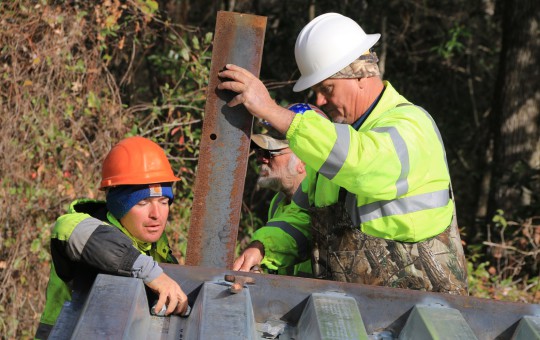 Fast forward to last Friday morning….the new 24-foot wide bridge arrived on a truck from the Big R Bridge company in three main pieces, plus guardrails and buckets of bolts. Think of it as a giant Erector Set.
Fast forward to last Friday morning….the new 24-foot wide bridge arrived on a truck from the Big R Bridge company in three main pieces, plus guardrails and buckets of bolts. Think of it as a giant Erector Set.
In just a few minutes, the three bridge sections were on the ground, and it was all hands on deck installing guardrails as simple as just bolting them on. By Saturday morning, the three sections were hoisted into place, creating the 40-foot span across Freeman Springs Branch.
For a photo gallery, click here.
“This is really promising,” Escambia County Commissioner Steven Barry said as he watched the bridge assembly. “This could very well be the future of bridges in Escambia County”
“I really think this will continue to be a good thing for the citizens of Escambia County,” Brown said. “It really saves times, and saves money. It ultimately is good thing for the citizens because we can get these bridges back open faster.”
The North Escambia area from Molino north to the Alabama line has been dotted with bridge closures over the past year or more. Some of the closures were planned projects funded by the state, while others were emergency closures due to an aging and failing infrastructure…most North Escambia bridges on county roads were constructed 50 or more years ago with concrete spans on wood pilings.
“We can’t use these metal span bridges on FDOT funded projects,” Brown said. “But we can look at the costs benefits on county projects that we fund.”
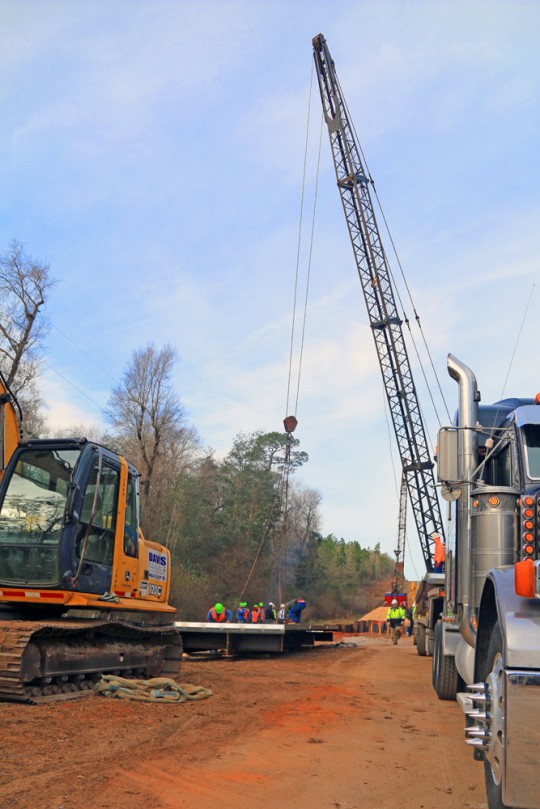 These are not those temporary metal bridges that North Escambia drivers have seen alongside some projects — those metal deck bridges that make the strange sounds as vehicles roll across.
These are not those temporary metal bridges that North Escambia drivers have seen alongside some projects — those metal deck bridges that make the strange sounds as vehicles roll across.
The new bridges are solid American steel with corrugated decks that are paved with asphalt after installation for decades of service.
“This bridge will probably save us over six months time in getting this road back open,” Assistant County Engineer Joy Jones said as she watched the bridge assembly on Arthur Brown Road.
“Time is important here,” Brown said, “even a life safety issue. The people on the other side of this bridge have been cut off from fire and EMS other services without a major detour.”
The cost for the actual bridge was around $80,000. The county still hired a contractor to construct the steel abutments to support the bridge and do the roadwork leading up to the bridge.
The project was slowed by the holiday period at the end of December and a week of weather too cold to pour concrete or lay asphalt, Jones said.
“We’ll probably have this back open within about a month,” she said.
For a photo gallery, click here.
NorthEscambia.com and courtesy photos, click to enlarge.
Comments
11 Responses to “Escambia County Explores How To Build A Bridge Faster, Smarter And Cheaper”



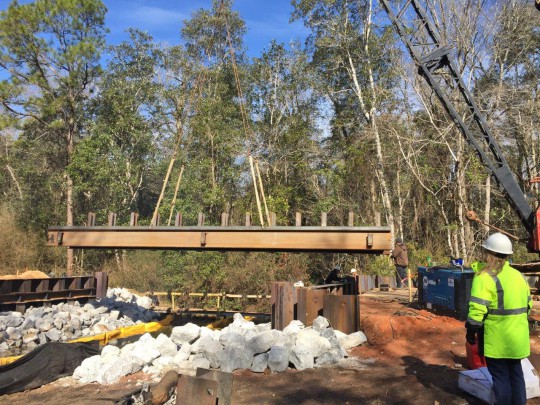
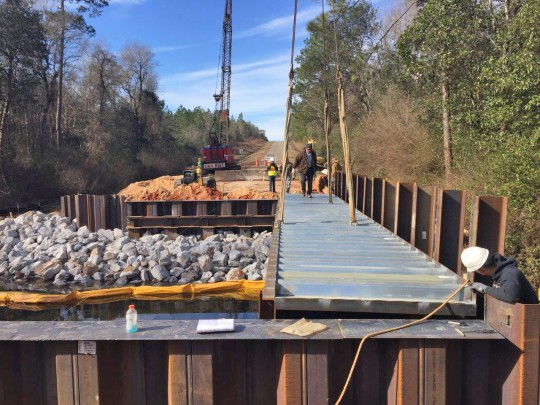
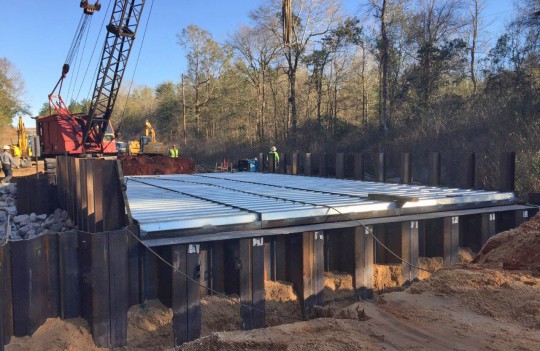
As many of the above comments have asked, what is the life expectancy and the span length? Also, who was the contractor? I would love to know more in this article about the bridge details, ie, length of the bridge deck how the abutments were constructed, etc.
Bridge builders are a special group. To me, it is amazing how they build these bridges. They always do a great job.
The contractor installed the abutment and Bridge.
The Road Dept. has since poured concrete on the deck and poured both concrete approaches. Monday we will start on the remaining work.
Thanks to all County Employees who are helping to get this completed as quickly as possible.
this is a good idea but have a few questions what is the life expecanty and the weight limit and the max distance it can span
What is real neat, and ironic, about this concept is, the U.S. Army combat engineers, went into Nazi Germany in WW II using similar, but a bit more primitive equipment. Their bridges crossed rivers that had their bridges destroyed by the retreating Germans. A big difference was they were being shot at by ground troops and strafed by the Luftwaffe.
Maybe it’s true….history repeats itself.
North Escambia .Com is on the ball with all these fine pictures there Motto Is All The News That’s Fit To Print.
Very innovative. Thanks Comm. Barry and Jack Brown.
Thank you Jack Brown for watching out for taxpayers and the safety of Escambia County bridges.
Your doing a great job!
Bridge building needs to be a speedy process given 21st century building and engineering technologies WITHOUT sacrificing quality construction.
Thanks Northescambia.com too!
They are finally realizing the hard-working taxpayers are tired of being ripped off lot of special favors going around if you know what I mean
This is encouraging and hopefully will be considered for the other county funded bridges in the North End. We’ve been saying it’s all fun and games (NOT!) – extra miles and time needed to navigate detours, travelling more on sloppy clay roads, and the impending rainy season when one of the remaining two roads out of La Floresta Perdida area is under water at its bridge – until someone needs an ambulance or the fire department.
Might I say this is great to see innovation for time and savings… BUT I wander what the Life expectancy is in the Florida weather and wander why they do not paint the metal to protect it from rust with some kind of coating? I worked many years in the Commercial Industry and the elements in Florida accelerates corrosion rapidly.
I worked with a Project many years ago where we provided the Government with a Product under extreme time restraint (Emergency) but the product failed quickly in exposure to the Elements. Might I say Florida rain, Flooding, Sun and Humidity and some areas Salt are brutal to steel.